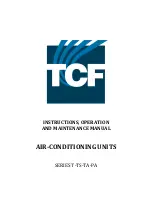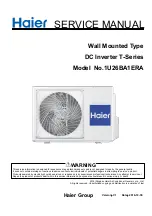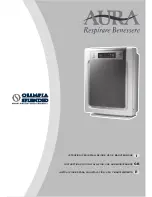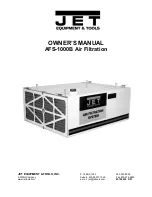
English
7
A. When the drain piping is tilted to the right, or to the right
and back.
Place it level, or tilt it slightly to the right or the back.
(Within 1°)
B. When the drain piping is tilted to the left, or to the left
and back.
Place it level, or tilt it slightly to the left or the back.
(Within 1°)
WARNING
The indoor unit must be securely installed on a place that
can withstand the mass.
If the strength is insufficient, the indoor unit may fall down
and cause injuries.
6.
REFRIGERANT PIPING WORK
• For the outdoor unit refrigerant piping, refer to the installation
manual attached to the outdoor unit.
• Carry out insulation of both gas and liquid refrigerant piping
securely. If not insulated, it may cause water leakage. For
gas piping, use insulation material of which heat resistant
temperature is not less than 120°C. For use under high
humidity, strengthen the insulation material for refrigerant
piping. If not strengthened, the surface of insulation material
may sweat.
• Make sure to check in advance that the refrigerant to be used
for installation work is according to the Outdoor Unit specifi-
cation. (Unless the refrigerant is correct type, the normal
operation cannot be expected.)
CAUTION
This air conditioner is a dedicated model for refrigerant
R410A or R32. Make sure to meet the requirements shown
right and carry out installation work.
• Use dedicated piping cutters and flaring tools according to
the used refrigerant type.
• When making a flare connection, coat the flared inner sur-
face only with ether oil or ester oil.
• Use only the flare nuts attached to the air conditioner. If
other flare nuts are used, it may cause refrigerant leak-
age.
• To prevent contamination or moisture from getting into the
piping, take measures such as pinching or taping the pip-
ings.
Do not mix substance other than the specified refrigerant
such as air into the refrigeration circuit.
If the refrigerant leaks during the work, ventilate the room.
• Remove the stay for packing and delivering (reinforcing
plate) before refrigerant piping work.
(Refer to Fig. 18)
• The refrigerant is pre-charged in the outdoor unit.
• When connecting the pipings to the air conditioner, make
sure to use a spanner and a torque wrench as shown in
Fig.13.
For the dimension of flared part, refer to the Table 1.
• When making a flare connection, coat the flared inner sur-
face only with ether oil or ester oil. (Refer to Fig. 14) Then,
turn the flare nut 3 to 4 times with your hand and screw in the
nut.
• For the tightening torque, refer to the Table 1.
Table 1
CAUTION
• Do not have oil adhere to the screw fixing part of resin parts.
If oil adheres, it may weaken the strength of screwed part.
• Do not tighten flare nuts too tight.
If a flare nut cracks, the refrigerant may leak.
CAUTION
Insulation of field piping must be carried out up to the con-
nection inside the casing. If the piping is exposed to the
atmosphere, it may cause sweating or burn due to touching
the piping, electric shocks or a fire due to the wiring touch-
ing the piping.
• After leak test, referring to Fig. 15, insulate both the gas and
liquid piping connection with the attached joint insulating
material (6) and (7) to prevent the piping from getting
exposed. Then, tighten the both ends of insulating material
with the clamp (4).
• Wrap the sealing material (Small) (9) around the joint insulat-
ing material (6) (flare nut section), only the gas piping side.
A
A.B
B
≤ 1°
≤ 1°
≤ 1°
Fig. 12
Piping size
(mm)
Tightening
torque (N·m)
Dimension
for processing
flare A (mm)
Flare shape
ø 6.4
15.7 ± 1.5
8.9 ± 0.2
ø 9.5
36.3 ± 3.6
13.0 ± 0.2
ø 12.7
54.9 ± 5.4
16.4 ± 0.2
ø15.9
68.6 ± 6.8
19.5 ± 0.2
Torque wrench
Spanner
Flare nut
Union joint
Fig. 13
Coat the flared inner surface
only with ether oil or ester oil.
Fig. 14
R0.4-0.8
90°±2°
A
45°±2°
4PEN469440-1D.book Page 7 Tuesday, June 27, 2017 10:55 AM








































